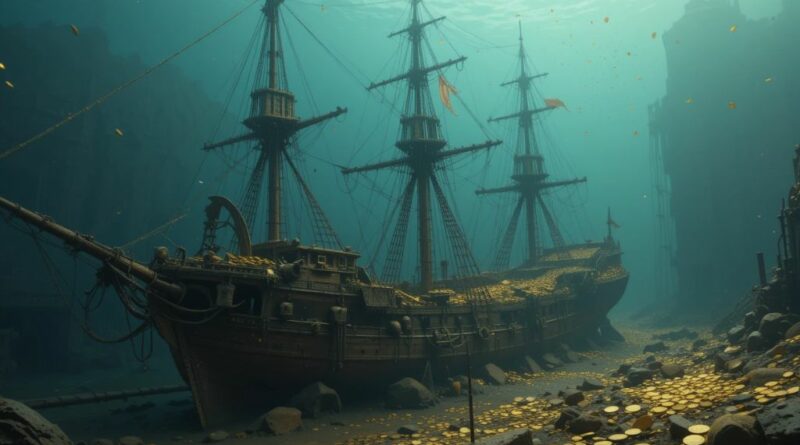The San José Galleon: The World’s Most Valuable Shipwreck
Three centuries after its dramatic demise in the turbulent waters off Colombia’s coast, the legendary Spanish galleon San José continues to captivate archaeologists, treasure hunters, and legal experts alike. Recent groundbreaking research has definitively confirmed what maritime historians have long suspected: the wreck discovered in 2015 is indeed the infamous “Holy Grail of shipwrecks,” laden with treasures valued at an astronomical $17 billion.
A Golden Discovery Beneath the Waves
The researchers describe seeing dozens of rough gold coins — the total number is not known — at several locations within the shipwreck, surrounded by other artifacts from the cargo, guns and everyday life as it was on board more than 300 years ago. The coins feature depictions of castles, lions and crosses on the front and the “Crowned Pillars of Hercules” above ocean waves on the back, according to a comprehensive study published in the prestigious journal Antiquity.
The latest forensic analysis, led by maritime archaeologist Daniela Vargas Ariza, represents a watershed moment in underwater archaeology. Using state-of-the-art remotely operated vehicles (ROVs), the international research team has meticulously documented the wreck site, revealing unprecedented details about the vessel’s tragic final voyage and its extraordinary cargo.
Most importantly, their high-res digital images show that the coins onboard the ship were minted in the year 1707 in Lima, the modern capital of Peru. This crucial dating evidence, combined with the distinctive craftsmanship of the coins, provides irrefutable proof of the wreck’s identity.
The Fateful Journey of 1708
The San José’s story begins in the early 18th century, during the height of Spanish colonial power in the Americas. This magnificent three-masted warship, bristling with 64 cannons and weighing over 1,000 tonnes, was no ordinary vessel. It served as the flagship of the Spanish treasure fleet, tasked with transporting the riches of the New World back to Europe.
In June 1708, the San José departed from Cartagena de Indias, the bustling colonial port that served as the gateway for Spanish treasure fleets. Similar to its surviving sister ship, San Joaquín, it had 11 million pesos in coins on board at the time of its sinking, worth up to $17 billion as of 2023. The silver and gold are from the mines of Potosí, Bolivia.
The treasure aboard the San José represented the wealth of an entire continent. Gold and silver extracted from the legendary mines of Potosí in Bolivia, precious gems from Colombian emerald mines, and exotic goods from across the Spanish Empire filled its cargo holds. The ship was essentially a floating treasury, carrying what would have been equivalent to a significant portion of Spain’s annual budget.
A Battle That Changed History
The San José’s fate was sealed on 8 June 1708, during the War of Spanish Succession. As the treasure fleet navigated the Caribbean waters near the Islas del Rosario, it encountered a British naval squadron commanded by Commodore Charles Wager. The British had been lying in wait, fully aware of the immense wealth aboard the Spanish vessels.
What followed was a fierce naval engagement that would echo through maritime history. The San José, alongside two companion ships, bravely engaged the five British warships whilst the remainder of the fleet retreated to the safety of Cartagena’s fortified harbour. The battle raged for hours, with cannon fire thundering across the waves.
In a tragic twist of fate, the San José’s own gunpowder stores ignited during the fierce combat, causing a catastrophic explosion that sent the ship and its precious cargo to the ocean floor. Of the approximately 600 souls aboard, only a handful survived to tell the tale. The sea had claimed not just lives, but one of the greatest treasures in human history.
Archaeological Detective Work
The rediscovery of the San José in 2015 marked the beginning of one of the most significant maritime archaeological projects of the 21st century. The Colombian government, working in partnership with the Woods Hole Oceanographic Institution, conducted extensive surveys of the wreck site using cutting-edge technology.
The recent study published in Antiquity represents years of painstaking analysis. While it was difficult to determine the exact number of coins on the seafloor, researchers found the coins were estimated to have an average diameter of 32.5 mm and (1.3 inches) and probably weigh about 27 grams (about 1 ounce).
The coins themselves are remarkable specimens of colonial craftsmanship. Known as “cobs” in English and “macuquinas” in Spanish, these hand-struck coins were the primary currency of the Spanish Americas for over two centuries. Each coin tells a story, bearing the distinctive markings of the Lima Mint and the assayer’s marks that guaranteed their gold content.
The archaeological team’s high-definition photography revealed intricate details that had remained hidden for three centuries. One side of the coins features a variation of the Jerusalem cross—one large cross framed by four smaller crosses—alongside a heraldic shield adorned with lions and castles, symbols of the Spanish crown. The reverse side displays the iconic “Crowned Pillars of Hercules above the waves of the sea,” a design element that specifically identifies these coins as products of the Lima Mint.
The Science of Underwater Preservation
The remarkable preservation of the San José’s treasures offers unique insights into underwater archaeology and marine preservation. The specific conditions of the Caribbean Sea floor, including temperature, salinity, and sediment composition, have created an environment that has protected organic and metallic materials for over three centuries.
The wreck site itself has become an underwater time capsule, preserving not only gold and silver but also everyday objects that provide invaluable glimpses into life aboard an 18th-century Spanish galleon. Archaeologists have documented cannons, anchors, navigational instruments, and personal effects that paint a vivid picture of maritime life during the colonial period.
This preservation phenomenon is not unique to the San José. Similar conditions have protected other famous shipwrecks, such as the Titanic and the Mary Rose, allowing modern researchers to unlock secrets that would otherwise have been lost to time.
A Legal Labyrinth Worth Billions
The confirmation of the San José’s identity has intensified an already complex legal battle that spans multiple continents and involves governments, corporations, and indigenous communities. The legal dispute over the San José galleon wreckage, one of history’s most significant maritime discoveries, has intensified as the Colombian government faces a $10 billion lawsuit from the US treasure hunting company Sea Search Armada (SSA). The dispute between the U.S. firm and the Colombian government is now before the Permanent Court of Arbitration at the Hague.
The legal complexities surrounding the San José are unprecedented in maritime law. Colombia asserts sovereignty over the wreck based on its location within Colombian territorial waters and a 2011 U.S. court ruling that declared the galleon property of the Colombian state. However, a U.S. court declared the galleon the property of the Colombian state in 2011, according to court documents. In 2018, UNESCO, the United Nations cultural agency, intervened when the Colombian government attempted to auction some of the San José’s artifacts to fund the recovery costs.
Spain, however, maintains a different position. According to Spain, neither Colombia nor SSA owns the San José, and the galleon and its treasure remain Spanish public property and are Spain’s underwater cultural heritage. This claim is based on the UNESCO Convention on the Protection of the Underwater Cultural Heritage, which recognises warships as the property of their flag state regardless of their current location.
Adding another layer of complexity, Indigenous peoples of Peru and Bolivia have also voiced objections on the basis that the San José’s cargo of gold was extracted from their ancestral lands through colonial exploitation. This perspective introduces questions of historical justice and the rights of indigenous communities to their cultural patrimony.
The Modern Treasure Hunt
The story of the San José also highlights the evolution of treasure hunting from romantic adventure to sophisticated scientific endeavour. Modern underwater archaeology employs advanced technologies that would have seemed like science fiction to earlier generations of treasure seekers.
The Colombian research team has utilised an impressive array of equipment, including:
- Autonomous Underwater Vehicles (AUVs) for wide-area surveying
- Remotely Operated Vehicles (ROVs) for detailed inspection and documentation
- Side-scan sonar for mapping the wreck site
- High-definition cameras for archaeological documentation
- Magnetometers for detecting metallic objects
- Sub-bottom profilers for understanding sediment layers
This technological approach represents a fundamental shift from the destructive treasure hunting of the past to careful archaeological preservation. Rather than simply extracting valuable objects, modern researchers are committed to understanding the historical context and cultural significance of their discoveries.
Economic and Cultural Implications
The $17 billion valuation of the San José’s treasure represents more than just monetary worth—it embodies centuries of cultural exchange, colonial history, and human endeavour. The economic implications of the find extend far beyond the immediate value of gold and silver coins.
For Colombia, the successful recovery and preservation of the San José could establish the country as a leader in underwater cultural heritage management. The development of specialised facilities, training programmes, and conservation techniques could position Colombia at the forefront of maritime archaeology in Latin America.
The potential tourism revenue from a properly curated San José exhibition could be substantial. The success of maritime museums such as the Vasa Museum in Stockholm and the Mary Rose Museum in Portsmouth demonstrates the public’s fascination with well-preserved historical vessels.
Environmental Considerations
The San José wreck site has also become an important marine ecosystem over the past three centuries. The ship’s structure provides habitat for various species of fish, corals, and other marine life. Any recovery operation must carefully balance archaeological objectives with environmental protection.
The Colombian government has committed to conducting any future excavation work according to international best practices for underwater cultural heritage. This includes comprehensive environmental impact assessments and the development of mitigation strategies to protect marine ecosystems.
Technological Innovation in Maritime Archaeology
The San José project has driven significant innovations in underwater archaeological techniques. The challenging conditions of deep-water archaeology—including limited visibility, strong currents, and the need for non-invasive documentation—have pushed researchers to develop new approaches to data collection and analysis.
Digital photogrammetry, for example, allows archaeologists to create precise three-dimensional models of artifacts and wreck sites without physically disturbing them. These models can be analysed, shared, and preserved indefinitely, creating a permanent record of the archaeological context.
Advances in underwater robotics have also been crucial to the project’s success. Modern ROVs can operate at depths and in conditions that would be impossible for human divers, allowing for extended observation periods and detailed documentation work.
The Global Context of Shipwreck Discovery
The San José is just one of thousands of shipwrecks that dot the world’s oceans, each representing a unique window into human history. The International Congress of Maritime Museums estimates that there are over three million shipwrecks on the ocean floor, ranging from ancient vessels to modern casualties.
Recent decades have seen remarkable discoveries that have transformed our understanding of maritime history. The Uluburun shipwreck off Turkey revealed Bronze Age trade networks, whilst the Belitung shipwreck provided insights into 9th-century maritime trade between China and the Middle East.
Each of these discoveries contributes to a growing understanding of how human civilizations have been connected by the sea throughout history. The San José, with its cargo from across the Spanish Empire, exemplifies these global connections on an unprecedented scale.
Future Prospects and Ongoing Research
This court case between Colombia and Sea Search Armada over the San Jose galleon is not just a legal battle but also a matter of national pride and heritage for Colombia. The decision of the tribunal will have lasting a impact on how historical treasures are protected and claimed globally.
The resolution of the legal disputes surrounding the San José will likely establish important precedents for future underwater cultural heritage cases. As technology makes deeper and more remote shipwrecks accessible, the international community must develop frameworks for balancing archaeological, cultural, and economic interests.
The Colombian government has indicated its intention to proceed with careful, scientifically-guided exploration of the wreck site, regardless of the ongoing legal challenges. Plans include the establishment of a dedicated research centre and museum facility that would serve as a focal point for Caribbean maritime archaeology.
Preserving History for Future Generations
The story of the San José serves as a powerful reminder of the importance of underwater cultural heritage preservation. As climate change, commercial fishing, and deep-sea mining threaten marine environments worldwide, the protection of archaeological sites becomes increasingly urgent.
The techniques developed for the San José project will undoubtedly inform future underwater archaeological endeavours around the world. From the Mediterranean to the South China Sea, researchers are applying similar approaches to unlock the secrets of our maritime past.
Conclusion: More Than Gold and Silver
The confirmation of the San José’s identity through its scattered gold coins represents far more than the discovery of treasure. It marks a triumph of scientific archaeology over commercial exploitation, international cooperation over nationalistic competition, and careful preservation over hasty extraction.
As the legal battles continue and the technological challenges of deep-water archaeology evolve, the San José remains a symbol of humanity’s complex relationship with its past. The ship’s tragic fate in 1708 has been transformed into a source of knowledge and wonder that will continue to educate and inspire future generations.
The true treasure of the San José may not be its gold and silver, but rather the stories it tells about colonial trade, maritime warfare, technological innovation, and the enduring human fascination with the sea’s mysteries. In an age of rapid technological change and global connectivity, this three-century-old shipwreck reminds us that the ocean continues to hold secrets that can transform our understanding of history.
Whether viewed through the lens of archaeology, economics, law, or environmental science, the San José galleon stands as one of the most significant maritime discoveries of our time. Its golden coins, scattered across the Caribbean sea floor, continue to glint with the promise of revelations yet to come.
We’d love your questions or comments on today’s topic!
For more articles like this one, click here.
Thought for the day:
“Self-discovery is above all the realization that we are alone: it is the opening of an impalpable, transparent wall – that of our consciousness – between the world and ourselves.”
Octavio Paz



